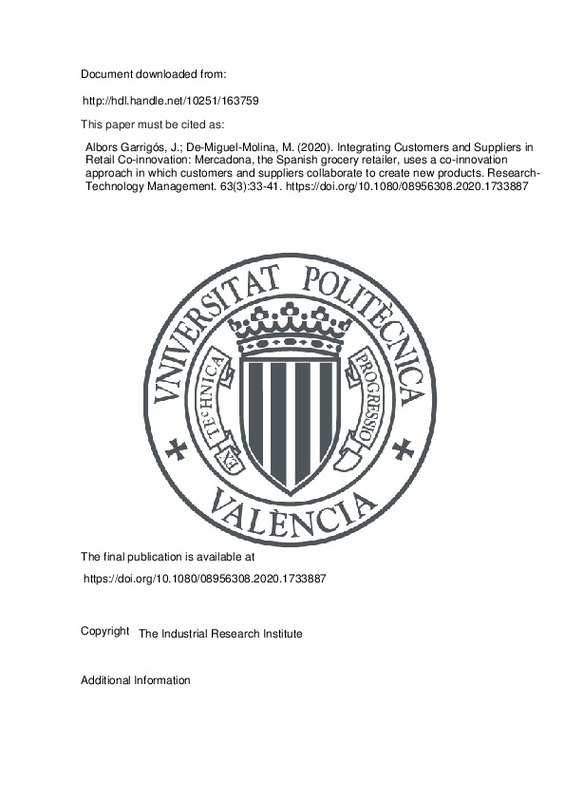JavaScript is disabled for your browser. Some features of this site may not work without it.
Buscar en RiuNet
Listar
Mi cuenta
Estadísticas
Ayuda RiuNet
Admin. UPV
Integrating Customers and Suppliers in Retail Co-innovation: Mercadona, the Spanish grocery retailer, uses a co-innovation approach in which customers and suppliers collaborate to create new products
Mostrar el registro sencillo del ítem
Ficheros en el ítem
| dc.contributor.author | Albors Garrigós, José
|
es_ES |
| dc.contributor.author | de-Miguel-Molina, María
|
es_ES |
| dc.date.accessioned | 2021-03-12T04:31:21Z | |
| dc.date.available | 2021-03-12T04:31:21Z | |
| dc.date.issued | 2020-05-03 | es_ES |
| dc.identifier.issn | 0895-6308 | es_ES |
| dc.identifier.uri | http://hdl.handle.net/10251/163759 | |
| dc.description.abstract | [EN] The retail grocery sector is not a leader in new product development due to inherent innovation risks and retailers' complex relationships with suppliers. Product co-innovation is an effective way to overcome innovation barriers and is feasible when retailers collaborate with customers and suppliers. We present a case study of Mercadona, a leading retailer in Spain that introduces new products developed using a novel co-innovation approach where customers and suppliers collaborate in innovation hubs from the start of the ideation phase. Other companies can learn from Mercadona's innovation journey over the last 20 years. | es_ES |
| dc.language | Inglés | es_ES |
| dc.publisher | The Industrial Research Institute | es_ES |
| dc.relation.ispartof | Research-Technology Management | es_ES |
| dc.rights | Reserva de todos los derechos | es_ES |
| dc.subject | Co-innovation | es_ES |
| dc.subject | Customer focus | es_ES |
| dc.subject | Retailing | es_ES |
| dc.subject.classification | ORGANIZACION DE EMPRESAS | es_ES |
| dc.title | Integrating Customers and Suppliers in Retail Co-innovation: Mercadona, the Spanish grocery retailer, uses a co-innovation approach in which customers and suppliers collaborate to create new products | es_ES |
| dc.type | Artículo | es_ES |
| dc.identifier.doi | 10.1080/08956308.2020.1733887 | es_ES |
| dc.rights.accessRights | Abierto | es_ES |
| dc.contributor.affiliation | Universitat Politècnica de València. Departamento de Organización de Empresas - Departament d'Organització d'Empreses | es_ES |
| dc.description.bibliographicCitation | Albors Garrigós, J.; De-Miguel-Molina, M. (2020). Integrating Customers and Suppliers in Retail Co-innovation: Mercadona, the Spanish grocery retailer, uses a co-innovation approach in which customers and suppliers collaborate to create new products. Research-Technology Management. 63(3):33-41. https://doi.org/10.1080/08956308.2020.1733887 | es_ES |
| dc.description.accrualMethod | S | es_ES |
| dc.relation.publisherversion | https://doi.org/10.1080/08956308.2020.1733887 | es_ES |
| dc.description.upvformatpinicio | 33 | es_ES |
| dc.description.upvformatpfin | 41 | es_ES |
| dc.type.version | info:eu-repo/semantics/publishedVersion | es_ES |
| dc.description.volume | 63 | es_ES |
| dc.description.issue | 3 | es_ES |
| dc.relation.pasarela | S\408587 | es_ES |
| dc.description.references | Bobot, L. (2011). Functional and dysfunctional conflicts in retailer‐supplier relationships. International Journal of Retail & Distribution Management, 39(1), 25-50. doi:10.1108/09590551111104468 | es_ES |
| dc.description.references | Cooper, R. G., & Edgett, S. J. (2008). Maximizing Productivity in Product Innovation. Research-Technology Management, 51(2), 47-58. doi:10.1080/08956308.2008.11657495 | es_ES |
| dc.description.references | Esbjerg, L., Burt, S., Pearse, H., & Glanz-Chanos, V. (2016). Retailers and technology-driven innovation in the food sector. British Food Journal, 118(6), 1370-1383. doi:10.1108/bfj-10-2015-0367 | es_ES |
| dc.description.references | Grimmer, L. (2017). The diminished stakeholder: Examining the relationship between suppliers and supermarkets in the Australian grocery industry. Journal of Consumer Behaviour, 17(1), e13-e20. doi:10.1002/cb.1674 | es_ES |
| dc.description.references | Helminen, P., Ainoa, J., & Mäkinen, S. (2015). Designing user innovation toolkits: exploring the interrelation between solution space and module library. International Journal of Design Creativity and Innovation, 4(3-4), 162-180. doi:10.1080/21650349.2015.1043351 | es_ES |
| dc.description.references | JANSSEN, K. L., & DANKBAAR, B. (2008). PROACTIVE INVOLVEMENT OF CONSUMERS IN INNOVATION: SELECTING APPROPRIATE TECHNIQUES. International Journal of Innovation Management, 12(03), 511-541. doi:10.1142/s1363919608002047 | es_ES |
| dc.description.references | Kim, S., Kim, N., Pae, J. H., & Yip, L. (2013). Cooperate «and» compete: coopetition strategy in retailer‐supplier relationships. Journal of Business & Industrial Marketing, 28(4), 263-275. doi:10.1108/08858621311313875 | es_ES |
| dc.description.references | Londoño, J. C., Elms, J., & Davies, K. (2016). Conceptualising and measuring consumer-based brand–retailer–channel equity. Journal of Retailing and Consumer Services, 29, 70-81. doi:10.1016/j.jretconser.2015.11.004 | es_ES |
| dc.description.references | Luceri, B., Sabbadin, E., & Zerbini, C. (2017). Innovation in Tradition: Key Success Factors of New Entrepreneurs in the Retail Trade. International Business Research, 10(12), 239. doi:10.5539/ibr.v10n12p239 | es_ES |
| dc.description.references | Pantano, E. (2014). Innovation drivers in retail industry. International Journal of Information Management, 34(3), 344-350. doi:10.1016/j.ijinfomgt.2014.03.002 | es_ES |
| dc.description.references | Pantano, E. (2016). Engaging consumer through the storefront: Evidences from integrating interactive technologies. Journal of Retailing and Consumer Services, 28, 149-154. doi:10.1016/j.jretconser.2015.09.007 | es_ES |
| dc.description.references | Schenk, E., & Guittard, C. (2011). Towards a characterization of crowdsourcing practices. Journal of Innovation Economics, 7(1), 93. doi:10.3917/jie.007.0093 | es_ES |
| dc.description.references | Shankar, V., Inman, J. J., Mantrala, M., Kelley, E., & Rizley, R. (2011). Innovations in Shopper Marketing: Current Insights and Future Research Issues. Journal of Retailing, 87, S29-S42. doi:10.1016/j.jretai.2011.04.007 | es_ES |
| dc.subject.ods | 08.- Fomentar el crecimiento económico sostenido, inclusivo y sostenible, el empleo pleno y productivo, y el trabajo decente para todos | es_ES |







![[Cerrado]](/themes/UPV/images/candado.png)

